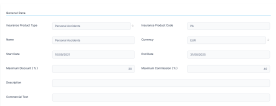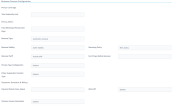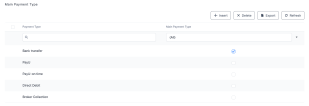Define the Product's Business Details
When creating a new insurance product, the Main Info tab lets you add information about your product, and also indicate some of its underlying business conditions. The tab has two sections:
-
General Data - This section lets you introduce the product's main characteristics, those which are most visible to the final customer.
-
Business Process Configuration - This section lets you configure the policy coverage, policy administration, the scheduling of payments and billing, the management of claims, the tariff type, and more.
Input the General Data and Configure the Business Process
In this section, generally describe your new product.
-
Fill in the following fields:
-
Insurance Product Type: Select a type of insurance for your insurance product - e.g. Auto, Health, Home, Travel. See Insurance Product Types for details;
-
Insurance Product Code: Fill in with a code of the insurance product. If you leave the field empty and you save the record, a code is automatically generated. You cannot edit a product without having the code.
-
Name: Insert the name of your insurance product;
-
Currency: Select a currency for your insurance product;
-
Start Date: Pick the date when your product becomes available;
-
End Date: Pick the date when the availability of your product ends;
-
Maximum Discount (%): Set the maximum percentage of the commercial discount which can be offered in the sales process for your product;
-
Maximum Commission (%): Set the maximum percentage of the commission which can be offered to intermediary sellers;
-
Description: Describe the insurance product ;
-
Commercial Text: Input the commercial text.
-
-
Move to the next section, Business Process Configuration, and fill in the following fields:
-
Total Indemnity Limit: Insert the maximum coverage amount provided per insurance policy;
-
Free Withdrawal Period Limit Days: Set the limit (expressed in days) for the free withdrawal period, if any;
-
Renewal Type: Choose the type of the insurance policy renewal.
The option set values are: [none], No (default), Automatic renewal, and Renewal offers.
If you choose Automatic renewal, the following option set fields become available:-
Renewal Validity: where the options are: Yearly, Monthly, and SameValidity;
-
Renewing Policy: where the options are: [none], Same Policy and New Policy;
-
Renewal Tariff: where the options are: Same tariff and Actual tariff;
-
No of Days Before Renewal: Insert the number of days before policies reach maturity that the system can use to notify you about the coming renewal opportunity.
-
-
Prorata Type Configuration: Set the proportion rate type for premium payments. The option set values are:
-
Default: if you allow the generic setting to be used;
-
Specific: if you want to set a specific rate. When you choose this option, the Prorata Type option set becomes available and you can choose between the following specific values: Daily and Monthly.
-
-
Policy Suspension Duration Type: Input the duration type for a policy suspension. It can be Default, as set in the general parameter, or Specific, where you can set up a custom value.
-
Payment Period Grace (days): Insert the number of days for the payment grace period;
-
Write off: Set the tolerance threshold for writing off payments that fall shorter than the expected agreed installment amount (for example $74.5 instead of $75). The option set values are: No write-off, Default, and Specific Write-off.
Choose:-
No write-off: if no rule for writing off is applied for your product;
-
Default: if you allow the default write-off settings to be used;
-
Specific Write-off: if you want to set the value for this parameter yourself. When you choose the Specific Write-Off option, a pop-up window appears and you can add your own key-value pairs, per different currencies in json file format. Set the desired values for this parameter. The values you insert are automatically saved.
-
-
Premium Invoice Generation: Configure the values to be used for automatic premium invoice generation. The option set values are: Default, Specific SGDAY* and Specific Day.
Choose:-
Default: if you allow the default setting to be used for automatic invoice generation;
-
Specific SGDAY: if you want to set a specific day for invoice generation. When you choose this option, the No. of Days in Advance (SGDAY) field becomes available and you can insert a specific number;
-
Specific Day: if you want the automatic invoice generation to be performed by the system on a specific day of the month. When you choose this option, the Specific day of the month field becomes available and you can specify a day of the month for generating the invoice.
-
-
Claim Notification Period Limit (hours): The period during which the claimant can notify the damage produced - in order to open a claim on a policy that contains this insurance product, expressed in hours;
-
Update Indemnity Limit: Check the box in order for the system to make automatic updates of the indemnity limit, after every claim payment;
-
Tariff Type: The tariff type options. The option set values are: Per Coverage and Per Product;
-
Underwriting Type: The underwriting type options. The option set values are: Per Coverage and Per Product.
-
-
Click Save and Reload. TheMain Payment Type insert form is displayed.
-
Choose the Main Payment Type from the list, containing the following options: Bank Transfer, PayU, PayU-on time, Direct Debit, and Broker Collection.
-
Click Save and Reload. The rest of the tabs are displayed, to continue configuring the insurance product.
-
Continue to tab 2, Insured Object Type.



